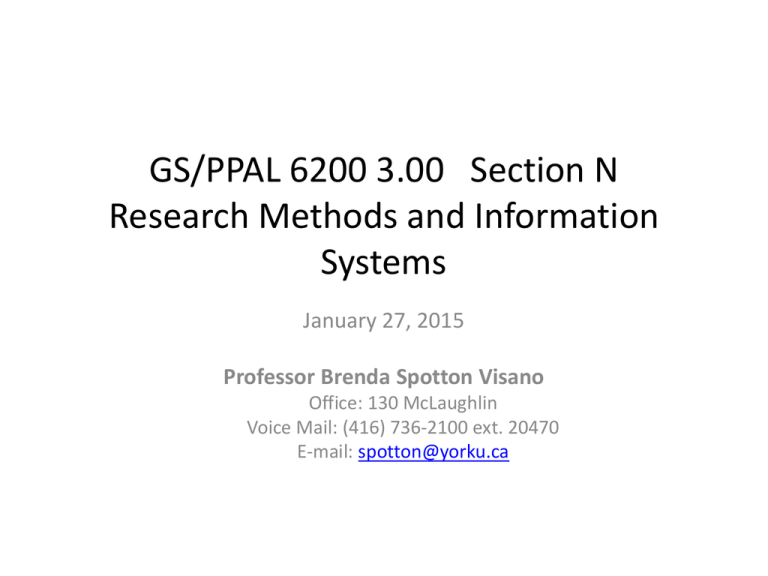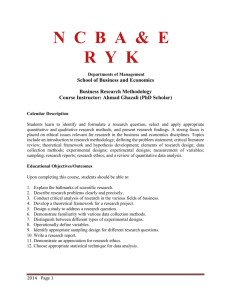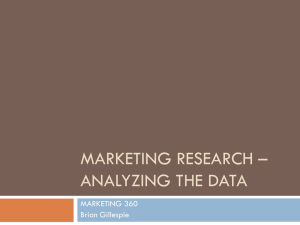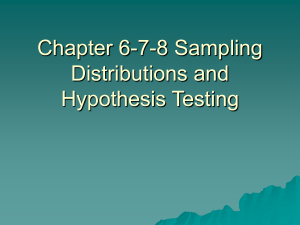Class Notes - York University
advertisement

GS/PPAL 6200 3.00 Section N Research Methods and Information Systems January 27, 2015 Professor Brenda Spotton Visano Office: 130 McLaughlin Voice Mail: (416) 736-2100 ext. 20470 E-mail: spotton@yorku.ca Agenda • Guest speaker: David Northrup, Institute for Social Research, York University • Review of last class • Methods of Knowing • Mill’s methods of knowing • Sampling and Measurement – precursor to causal inference Review of Last Class • Introduction to Information Ethics – explore the advantages and disadvantages of privacy dilemma of public records on the internet – What are the benefits of the “public record” and publicly available information? (A critical question in a world of e-government as the electronic provision of information via the internet): public sector accountability, increased civic participation, increased public security – What are the negative consequences of publicly available personal information? Identity theft, vulnerable groups at risk of discrimination, safety risks, justice only for those who can afford costly challenges • Principles of Access and Privacy per Ontario Privacy Commissioner • FYI - “Public Records on the Internet: The Privacy Dilemma” Beth Givens (2006) https://www.privacyrights.org/ar/onlinepubrecs.htm Review of Last Class (cont’d) • Introduction to Research Ethics Scope (Protection of human and animal subjects, Biosecurity, Collection, use and interpretation of data, Reporting and reviewing research plans, findings, Relationships between researchers (authorship, collaboration), researcher and subject/those affected by research, conflicts of interest, whistleblowing, Means of responding to disputes) • Relationship between York University Research Ethics Policy, Tri-Council Policy, Information Ethics Sample Questions to which we might seek an Answer Physical Phenomenon • How do we know ice is cold? • How could we test a hypothesis that states “all things frozen are cold”? Social Phenomenon • How could we test a hypothesis that states “minimum wage policies cause unemployment”? Methods of Knowing http://poli.haifa.ac.il/~levi/method.html • “Ice is cold” - How do we “know” this? • Common "ways of knowing“ include…? • Alternative Hypothesis: All things frozen are cold (onetail or two-tail hypothesis?) • and the Null Hypothesis? – All things frozen are warm (not cold) or – Not all things frozen are cold (some are warm, some are cold) • Implied causality: Freezing causes cold. • Sampling for generalizibility Causality • David Hume (1711-1776) A Treatise of Human Nature, 1738; Hume’s Causality: • Precedence (X precedes Y in time) • Contiguity (X and Y are contiguous in time and space) • Constant Conjunction (X and Y always co-occur) • John Stuart Mill (1806-1873), A System of Logic, 1843 – Methods of (1) Agreement, (2) Difference, (3) Joint Agreement and Difference, and (4) Concomitant Variation Method of Direct Agreement (Symbolic representations from http://en.wikipedia.org/wiki/Mill%27s_Methods) – A B C D occur together with w x y z – A E F G occur together with w t u v – Therefore A is the cause, or the effect, of w • Example of test for “ice is cold”? • Example of test for minimum wage causes unemployment? • Assumes: – There is a unique cause – That cause is included in the set of possibilities investigated – Invariance in patterns investigated – Correlation implies causation Method of Difference – A B C D occur together with w x y z – B C D occur together with x y z – Therefore A is the cause, or the effect, or a part of the cause of w. • Example of test for “ice is cold”? • Example of test for minimum wage causes unemployment? Joint Method of Agreement and Difference – A B C occur together with x y z – A D E occur together with x v w – also B C occur with y z – Therefore A is the cause, or the effect, or a part of the cause of x. • Example of test for “ice is cold”? • Example of test for minimum wage causes unemployment? Method of concomitant variations – A B C occur together with x y z – A± B C results in x± y z. – Therefore A and x are causally connected • Example of test for “ice is cold”? • Example of test for minimum wage causes unemployment? What Cases are Looking at? • • • • Representative – typical of category? Prototypical? – expected to become typical? Deviant? – an exception to the norm? Crucial? – tests the hypothesis in the least favorable conditions • Archetypical? – creates a category? Strategies for selecting cases to study (i.e., a sample) Probability sampling: • Random Sampling – easy to do and explain, but not the statistically efficient, and may not be a good representation of sub-groups • Stratified Random Sampling – take a simple random sample from subgroups of the population • Systematic random sampling – take every kth unit where k = N/n Strategies for selecting cases to study (i.e., sample) Non-probability Sampling • Convenience sampling – representative of the population? • Purposive sampling – reaches a target population • Expert sampling – convene a panel of experts • Snowball sampling – first respondents recommend others to be included Cases versus variables http://poli.haifa.ac.il/~levi/res/case3.htm • Variables: any entity that can take on different values • Cases: specific individual or specific context - Are cases made or are they found? Are cases objects or are they conventions? • Is a social class a case or a variable? • Is an analysis of United States census data a study of many cases (individuals) or one case (the United States)? • Are case designations specific (e.g., the "authoritarian personality" or the "anti-neocolonial revolution") and developed in the course of research (e.g., through in-depth interviews or historical research) or are they general (e.g., individuals, families, cities, firms) and relatively external to the conduct of research?











